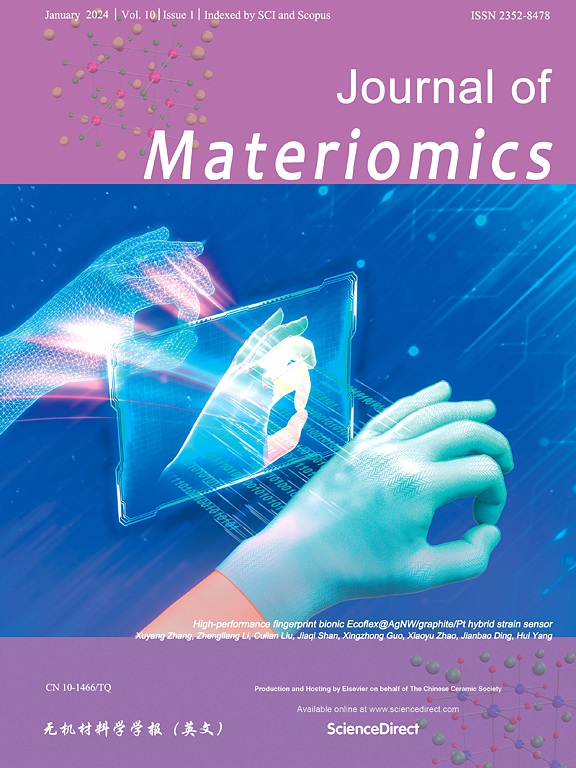一种制备高能量储存密度、高效率、低烧结温度的锆酸铅基陶瓷的混合加工技术
IF 9.6
1区 材料科学
Q1 CHEMISTRY, PHYSICAL
引用次数: 0
摘要
对于多层陶瓷电容器来说,陶瓷内电极共烧结是一个关键问题。这就要求陶瓷材料具有较低的烧结温度。针对这一准则,本研究提出了一种混合处理技术。该技术包括将煅烧的陶瓷粉末与溶胶溶液混合以获得复合粉末。最终,得到的复合材料的烧结温度从1300℃降低到1120℃。这是因为溶胶溶液引入了更大的比表面积和更多的氧空位,从而增强了化学反应活性。所制备的陶瓷粉体和溶胶溶液分别为(Pb0.94La0.04)(Zr0.51Sn0.47Hf0.01Ti0.01)O3和(Pb0.97La0.02)(Zr0.6Sn0.4)O3。这种成分设计有助于提高介电常数和极化强度。同时,由于溶胶溶液产生的强界面电阻,可以显著提高界面绝缘和电击穿强度。因此,在此工作中获得了高达12.4 J/cm3的高能量存储密度和92.4%的效率。总的来说,这项技术适用于广泛的陶瓷材料系统,并提供了一种创新的陶瓷设计和制造。本文章由计算机程序翻译,如有差异,请以英文原文为准。


A hybrid processing technology for fabricating lead zirconate-based ceramics with high energy storage density, high efficiency, and low sintering temperature
For multilayer ceramic capacitors, co-sintering of ceramics with inner electrodes is a crucial issue. This requires ceramic materials to have a low sintering temperature. In response to this criterion, a hybrid processing technology is proposed in this study. This technology involves mixing of calcined ceramic powders with sol solutions to obtain composite powders. Eventually, sintering temperature of the obtained composite material is reduced from 1300 °C to 1120 °C. This is originated from the introduction of more specific surface areas and more oxygen vacancies by sol solutions, leading to an enhancement of chemical reaction activity. The ceramic powders and the sol solutions used in this work are (Pb0.94La0.04)(Zr0.51Sn0.47Hf0.01Ti0.01)O3 and (Pb0.97La0.02)(Zr0.6Sn0.4)O3, respectively. Such composition design helps improve the dielectric constant and polarization intensity. While in the meantime, because of the strong interfacial resistance caused by sol solutions, interfacial insulation as well as electrical breakdown strength can be significantly improved. Consequently, a high energy storage density up to 12.4 J/cm3 and an efficiency of 92.4% is obtained in this work. Overall, this technology is applicable to a wide range of ceramic material systems, and provides an innovative design and manufacture of ceramics.
求助全文
通过发布文献求助,成功后即可免费获取论文全文。
去求助
来源期刊

Journal of Materiomics
Materials Science-Metals and Alloys
CiteScore
14.30
自引率
6.40%
发文量
331
审稿时长
37 days
期刊介绍:
The Journal of Materiomics is a peer-reviewed open-access journal that aims to serve as a forum for the continuous dissemination of research within the field of materials science. It particularly emphasizes systematic studies on the relationships between composition, processing, structure, property, and performance of advanced materials. The journal is supported by the Chinese Ceramic Society and is indexed in SCIE and Scopus. It is commonly referred to as J Materiomics.
 求助内容:
求助内容: 应助结果提醒方式:
应助结果提醒方式:


